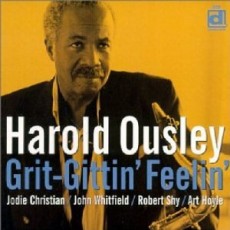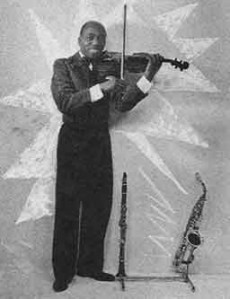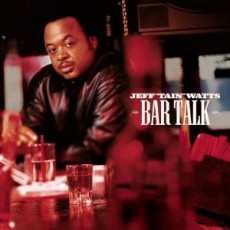
Daily Dose Of Jazz…
Tiny Winters was born Frederick Gittens on January 24,1909 in London, England. He learned the violin as a child but switched to the double bass, developing a pizzicato style based on New Orleans bass man Pops Foster.
By the 1920s he was he was working with the Roy Fox Band, then with pianist and arranger Lew Stone in the 30s. Utilizing his unusually high vocal talents to cover Ella Fitzgerald hits, he would get fan mail addressed to Miss Tiny Winters.
He would go on to play with Ray Noble, record with Coleman Hawkins and began leading his own groups by 1936. With his notoriety established he played regularly at the Hatchett Club and freelanced as a session player in theatrical orchestras for shows like Annie Get Your Gun and West Side Story.
Tiny would later play with Digby Fairweather in the Kettner’s Five, record with Benny Waters, was the bassist and featured comedian with George Chisholm in The Black and White Minstrel Show. During the late Eighties Winters would lead the Café Society Orchestra and his own Palm Court Trio, write his autobiography “It Took A Lot Of Pluck” and retired in the 90s after being awarded the Freedom of the City of London. Bassist, vocalist and bandleader Tiny Winters passed away February 7, 1996.
More Posts: bass

Daily Dose Of Jazz…
Harold Lomax Ousley was born January 23, 1929 in Chicago, Illinois. Heavily influenced by Gene Ammons, he began playing tenor saxophone and flute in the late 1940s. In the 1950s he recorded behind vocalists such as Billie Holiday and Dinah Washington. Throughout the decade Harold also played as a sideman with Gene Ammons and with Jack McDuff and George Benson in the 1960s.
Ousley released his first record as a leader in 1961 titled Tenor Sax on the Bethlehem label. He would go on to lead five more session up to the new millennium for Muse, Cobblestone, Digi-Rom, Tele-Jazz and Delmark labels. His 16-bar blues boogaloo “Return of the Prodigal Son” demonstrated his flair but was a hit on George Benson’s Cookbook release.
During the 1970s Harold was playing with Lionel Hampton and Count Basie but his star was fading to the rise of fusion and then resurgent mainstream. He moved into cable television production featuring jazz performance and interviews, not recording again until the late 90s.
Though he heavily resides in blues, Ousley quickly cites Charlie Parker as his first model for the hard bop lines in his music. However the gentler side of this tenor is the sweet sound of his ballads. Tenor saxophonist Harold Ousley passed away on August 13, 2015 in Brooklyn New York.
More Posts: saxophone

Daily Dose Of Jazz…
Juan Tizol was born on January 22, 1900 in Vega Baja, Puerto Rico and from an early age music was in his life with his first instrument being the violin, but soon switched to valve trombone, his career choice. His uncle Manuel Tizol, music director of the San Juan symphony taught his mostly throughout his youth. He played in his uncle’s band and also gained experience by playing in local operas, ballets and dance bands.
By 1920, Juan joined a band that was traveling to the U.S. to work in Washington D.C. The group eventually made it to Washington, traveling as stowaways, and established residence at the Howard Theater where they played for touring shows and silent movies. At the Howard they also were hired to play in small jazz or dance groups. This is where Juan first came in contact with Duke Ellington.
Tizol got the call to join the Ellington band in the summer of 1929 and became the fifth voice in the brass section of Ellington’s orchestra. This opened up new possibilities for Duke’s writing, as he now could write for trombones as a section instead of just having them play with the trumpets. Juan’s rich, warm tone also blended nicely with the saxophone section, so he was often scored carrying the lead melody with the saxophones.
Juan made many contributions to the Ellington band throughout the 1930s and 40s. One of his major roles in the band was copying parts from Ellington’s scores. Besides copying, Juan also was a band composer. His best-known compositions, Caravan and Perdido are still played by jazz musicians today. Tizol was responsible for bringing Latin influences into the Ellington band with compositions such as Moonlight Fiesta, Jubilesta, Conga Brava, and others.
Juan left Ellington’s band in 1944 to play in the Harry James Orchestra in Los Angeles, to spend more time with his wife. He returned to Ellington in ‘51, but returned to James two years later and remained predominantly on the West Coast for the remainder of his career, playing sporadically with Harry James, Nelson Riddle, and on the Nat King Cole television show.
After another short stint with Ellington in the ‘60s, trombonist Juan Tizol eventually retired in Los Angeles and passed away on April 23, 1984 in Inglewood, California.
More Posts: trombone

Daily Dose Of Jazz…
Juice Wilson, born on January 21, 1904 grew up an orphan and was raised by his uncle from age three in Chicago. He began playing drums in the Chicago Militia Boys Band, and then switched to violin at age eight. By the age of twelve he was already playing with Jimmy Wade, and at 14 he performed with Freddie Keppard.
Juice worked on steamboats on the Great Lakes and did extended residencies with Jimmy Harrison in Ohio. Early in the 1920s he worked in Erie with Hersal Brassfield, moved to Buffalo, New York to play with Eugene Primus as well as the Buffalo Junior Symphony Orchestra.
By 1928, Wilson moved to New York City and played with Lloyd Scott at the Savoy Ballroom. At the end of the decade he toured Europe with Noble Sissle, and decided to remain there, working in Holland with Ed Swayzee, Leon Abbey, the Utica Jubilee Singers, the Louis Douglass Revue, Little Mike McKendrick’s International Band and Tom Chase.
He made trips to Spain and North Africa before settling in Malta, where he became a local star. He worked there through much of the 1940s and 1950s as a multi-instrumentalist, and made further tours around the Mediterranean before coming back to the United States in the 1960s.
Jazz violinist Juice Wilson died peacefully on May 22, 1993.
More Posts: violin

Daily Dose Of Jazz…
Jeff “Tain” Watts was born on January 20, 1960 and initially studied classical percussion at Pittsburgh’s Duquesne University, where he was primarily a timpanist. This he followed by enrollment at the Berklee School of Music, where he pursued jazz studies alongside Branford Marsalis, Kevin Eubanks, Greg Osby, Aimee Mann, Steve Vai and Marvin “Smitty” Smith.
Jeff joined the Wynton Marsalis Quartet in 1981 and proceeded to win three Grammy Awards with the ensemble. Leaving Wynton Marsalis in 1988 work followed with George Benson, Harry Connick, Jr. and McCoy Tyner; prior to joining the Branford Marsalis Quartet in 1989.A move to Los Angeles, California for three years had him working in the film and television industry as both a musician on the Tonight Show with Jay Leno and as an actor, Rhythm Jones in Spike Lee’s “Mo Better Blues”.
Returning to New York in ’95, Jeff joined Kenny Garrett’s band and also continued to record and tour with Branford Marsalis as well as Danilo Perez, Michael Brecker, Betty Carter, Kenny Kirkland, Courtney Pine, Geri Allen, Alice Coltrane, Michael Brecker, Greg Osby, Steve Coleman, Gonzalo Rubalcaba, Ravi Coltrane, George Cables and McCoy Tyner.
Jeff “Tain” Watts got his nickname from Kenny Kirkland while on tour in Florida and past a Chieftain gas station. He has won a Best Instrumental Solo Grammy for “Dark Key Music” in 2010 and also holds the unique distinction of being the only musician to appear on every Grammy Award winning jazz record by both Wynton and Branford Marsalis. As a composer, Watts is a creative and innovative force in modern jazz, contributing most of the compositions on his own albums.
More Posts: drums






